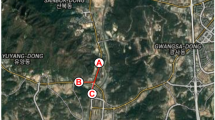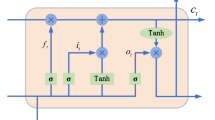Abstract
The safety and health monitoring of dams has attracted increasing attention. In this paper, a novel prediction model based on variational autoencoder (VAE) and temporal attention-based long short-term memory (TALSTM) network is proposed for the long-term deformation of arch dams. In the proposed model, the convolutional neural network-based VAE is applied to extracting the features of environmental data. The TALSTM is employed to construct the relationship between the dam displacement and extracted features. For verification, an arch dam is taken as an example. Through the comparison among nine baseline prediction models, the proposed model is more stable and effective than other prediction models. Furthermore, the proposed model could capture the features of environmental data accurately and provide better prediction results. Therefore, the proposed model is more suitable for engineering applications.















Similar content being viewed by others

References
Bui K-TT, Bui DT, Zou J, Van Doan C, Revhaug I (2016) A novel hybrid artificial intelligent approach based on neural fuzzy inference model and particle swarm optimization for horizontal displacement modeling of hydropower dam. Neural Comput Appl 29:1495–1506
Chen B, Hu T, Huang Z, Fang C (2018) A spatio-temporal clustering and diagnosis method for concrete arch dams using deformation monitoring data. Struct Heal Monit 18:1355–1371
Shu X, Bao T, Li Y, Zhang K, Wu B (2020) Dam safety evaluation based on interval-valued intuitionistic fuzzy sets and evidence theory. Sensors 20:2648
Willm G, Beaujoint N (1967) Les méthodes de surveillance des barrages au service de la production hydraulique d'Electricité de France, problèmes anciens et solutions nouvelles. In: IXth international congress on large dams
Wu ZR, Shen CS, Ruan HX (1988) Factor selection of statistical model for concrete dam deformation. J Hohai Univ 16(6):1–9
Gu CS, Li Y, Song JX (2010) Study on safety monitoring model for deformation of RCCD. Chin J Comput Mech 27(2):286–290
Gu CS, Li B, Xu BS, Hu J (2008) Safety monitoring model of roller-compacted concrete dam seepage. J Hohai Univ (Natural Sciences) 36(5):579–584
Su H, Li X, Yang B et al (2018) Wavelet support vector machine-based prediction model of dam deformation [J]. Mech Syst Signal Process 110:412–427
Li LH, Peng SJ, Jiang ZX (2014) Prediction model of concrete dam deformation based on adaptive unscented Kalman Filter and BP neural network. Appl Mech Mater 513:4076–4079
Li Y, Bao T, Gong J et al (2020) The prediction of dam displacement time series using STL, extra-trees, and stacked LSTM neural network [J]. IEEE Access 8(99):1–1
Liu W, Pan J, Ren Y et al (2020) Coupling prediction model for long-term displacements of arch dams based on long short-term memory network[J]. Struct Control Health Monit 27:e2548. https://doi.org/10.1002/stc.2548
Wang YH, Xu C (2010) Using genetic artificial neural network to model dam monitoring data. Second Int Conf Comput Model Simul 2:3–7
Kingma DP, Welling M (2014) Auto-encoding variational bayes[C]. In: International conference on learning representations
Boquet G, Morell A, Serrano J et al (2020) A variational autoencoder solution for road traffic forecasting systems: Missing data imputation, dimension reduction, model selection and anomaly detection[J]. Transp Res Part C Emerg Technol
Ma X, Lin Y, Nie Z et al (2020) Structural damage identification based on unsupervised feature-extraction via Variational Auto-encoder[J]. Measurement 107811
Fan Y, Wen G, Li D et al (2018) Video anomaly detection and localization via gaussian mixture fully convolutional variational autoencoder[J]. Comput Vis Image Underst
Xie R, Jan NM, Hao K et al (2020) Supervised variational autoencoders for soft sensor modeling with missing data[J]. IEEE Trans Ind Inf 16(4):2820–2828
Blei DM, Kucukelbir A, Mcauliffe J et al (2017) Variational inference: a review for statisticians[J]. J Am Stat Assoc 112(518):859–877
Rawat W, Wang Z (2017) Deep convolutional neural networks for image classification: a comprehensive review. Neural Comput 29(9):2352–2449
Kim D, Park C, Oh J et al (2016) Convolutional matrix factorization for document context-aware recommendation[C]. In: Conference on recommender systems, pp 233–240
Yin Y, Chen L, Xu Y et al (2019) QoS prediction for service recommendation with deep feature learning in edge computing environment[J]. Mobile Netw Appl:1–11
Ma C, Huang J, Yang X et al (2019) Robust visual tracking via hierarchical convolutional features[J]. IEEE Trans Pattern Anal Mach Intell 41(11):2709–2723
Dung CV, Anh LD (2019) Autonomous concrete crack detection using deep fully convolutional neural network[J]. Autom Construct:52–58
Hochreiter S, Schmidhuber J (1997) Long short-term memory[J]. Neural Comput 9(8):1735–1780
Zhou G, Wu J, Zhang C et al (2016) Minimal gated unit for recurrent neural networks[J]. Int J Autom Comput 13(3):226–234
Zhao R, Wang D, Yan R et al (2018) machine health monitoring using local feature-based gated recurrent unit networks[J]. IEEE Trans Ind Electron 65(2):1539–1548
Tai KS, Socher R, Manning CD (2015) Improved semantic representations from tree-structured long short-term memory networks[J]. Comput Lang 5(1):36
Vaswani et al (2017) Attention is all you need. Adv Neural Inf Process Syst
Wang Q, Hao Y (2020) ALSTM: an attention-based long short-term memory framework for knowledge base reasoning[J]. Neurocomputing 399:342–351
Du S, Li T, Yang Y et al (2020) Multivariate time series forecasting via attention-based encoder-decoder framework[J]. Neurocomputing:269–279
Xiao X, Zhang D, Hu G et al (2020) CNN-MHSA: a convolutional neural network and multi-head self-attention combined approach for detecting phishing websites[J]. Neural Netw 125:303–312
Acknowledgements
Some or all data, models, or code generated or used during the study are available from the corresponding author by request.
Funding
This work was supported by the National Key R&D program of China (2018YFC1508603), the National Natural Science Foundation of China (Grant nos. 51579086, 51739003).
Author information
Authors and Affiliations
Contributions
Conceptualization: XS and TB; methodology: XS and TB; validation: XS, YL and JG; formal analysis: XS, YL, JG and KZ; data curation: XS, YL and JG; writing—original draft preparation, XS and TB; writing—review and editing, XS and TB; funding acquisition, TB.
Corresponding author
Ethics declarations
Conflict of interest
The authors declare no conflict of interest.
Rights and permissions
About this article
Cite this article
Shu, X., Bao, T., Li, Y. et al. VAE-TALSTM: a temporal attention and variational autoencoder-based long short-term memory framework for dam displacement prediction. Engineering with Computers 38, 3497–3512 (2022). https://doi.org/10.1007/s00366-021-01362-2
Received:
Accepted:
Published:
Issue Date:
DOI: https://doi.org/10.1007/s00366-021-01362-2



